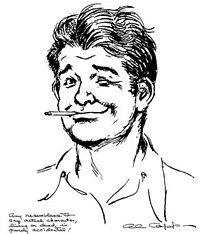Looking for design inspiration? Browse our curated collections!
September 27th, 2015 - 10:59 AM

“In my youth I stressed freedom, and in my old age I stress order. I have made the great discovery that liberty is a product of order.” -- William Durant
To counter balance the panoply of left leaning artists whom I have come across in person and in books, I searched for the alternative and found the political cartoonist Al Capp. It turned out that he stood for civil rights, and attacked the excesses of corporate lust and corrupt politicians. Was I dealing with a populist progressive instead? And not only that, he had a charitable heart allegedly giving to people in need without the fanfare of the press. He also provided artwork for nonprofits, civic groups and the government. All of these are presentiments of his being a Liberal. He was even a lifelong friend of Walt Kelly of Pogo fame!
But then I found something interesting. He offered his service to a fundraiser for Jack Kemp when the latter was in Congress. And he opposed funding for Public Television's Sesame Street convinced that educational comics constitute a less costly alternative that would encourage youngsters to read. He held that subsidizing educational comics would be cheaper than funding for Sesame Street. Youngsters would not have had to learn to read to watch Sesame Street but such would not have been the case for enjoying informative comic strips.
So what happened? Was Al Capp, to use the 'L' word, a flaming Liberal or was he a closet Conservative? Like the fictional cartoonist who had once gotten into trouble for being a Liberal in the novella Las Reputaciones by the Columbian author Juan Gabriel Vasquez, Al Capp had undergone a transformation from being a New Deal Democrat to embracing a far more conservative position. One started out being a reformer, a dreamer who sees the world in its starkness as only the contrast of deep shadows against spots of illumination. One then ended up seeing a blend where there once was contrast no longer dreaming having awakened to the complex weave of reality.
He was caught up in the freneticism of the Sixties – a time when people hunkered down in their trenches harboring an us versus them mentality countering age-old ills with militancy and opposing such with equal intensity. Reacting to on-campus excesses that were captured by the press he turned his brazened style from attacking corporate bigwigs to counter cultural icons.
And yet one cannot classify Capp as a social conservative/ He supported Gay rights never tolerating any humor targeting this group.. Still supporting civil rights, he was uncomfortable with the Black Power movement. What we find is an enigmatic man who paid no heed to labels. He was not a Liberal to be sure. Neither can one safely say that he was solidly in the Conservative camp. In other words, he was his own man.
Al Capp was an heir to a long line of artists who strayed outside of the norm looking at our society from the outside. There were the observations of Mark Twain of a divided society. And then we have had the dark humor of Ambrose Bierce. In science fiction there was the acerbic humor and satire of Kurt Vonnegut. But Al Capp was a cartoonist yet he wrote the captions and hence can be included in this broad category of writers who looked at our world from the outside.
And we see this with painters as well. Take for example Pablo Picasso who had gone into exile because of Franco's victory in his native Spain eventually joining the French Communist Party in 1944 but he could not possibly adhere to all of its strictures. For instance, he signed a letter protesting the Soviet invasion of Hungary. This was in direct opposition to the party line. While officially a member he could not abide even in spirit to its ethos.
On the other hand, Salvador Dali openly endorsed Franco applauding his rise to power and the fall of the Republic. But Dali lived abroad. He painted his surrealist work “Soft Construction with Boiled Beans” at the dawn of the Spanish Civil War lamenting the unfolding tragedy tearing apart his country.
We can accuse Dali of endorsing and celebrating Franco's rise to power. Yet his close friend at the Residencia was the great Spanish poet Federico García Lorca murdered by Franco's henchmen. And he collaborated with the Mexican film director Luis Buñuel in the making of the movie Un Chien Andalou. The second surrealist cinematic collaboration was the making of the film L'Age d'Or. But they had a falling out, in part over politics and Dali removed his participation from the actual shooting of the film. And there was a public outcry against this film as it linked Jesus Christ with the writings of Marat de Sade thus anticipating Andres Serrano's “Piss Christ.” What is in common with this panoply of maverick artists (writers and painters) is not their politics but their restlessness that while adhering to a viewpoint may change their minds but remain always on the outside poking fun at or dismantling our cherished icons.
And this is the signature of artistic expression that the maker is not beholden to any ideology or political platform. Once he becomes a slave to the party or government line, his art withers.
Comments
There are no comments on this blog. Click here to post the first comment.